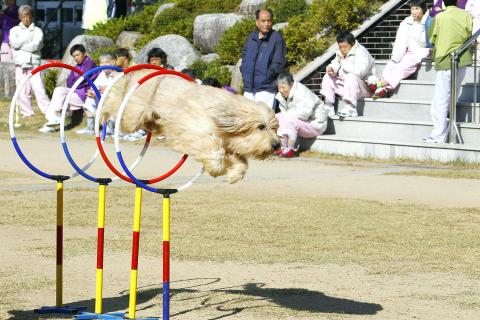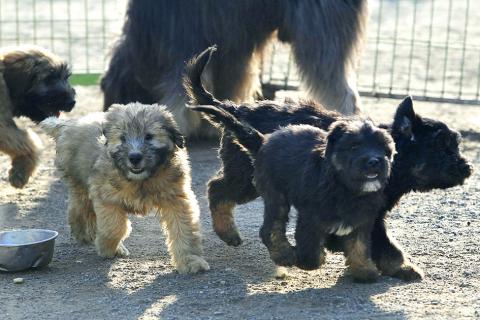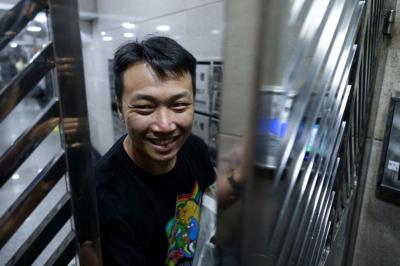Decades of colonial occupation, war and poverty took a deadly toll not just on millions of Koreans, but also one of the country’s traditional and beloved breeds of dogs.
Sapsarees, shaggy-haired dogs long valued for their loyalty, were killed in large numbers by the Japanese military, which used their fur to make winter coats for its soldiers serving in the extreme cold of Manchuria, as documented in government records during the period of Japanese colonial rule from 1910 to 1945.
When South Korea emerged from the turmoil of two wars and decades of poverty, the medium-sized Sapsaree, whose name means “the dogs that ward off evil spirits or misfortune” and which resembles a sheepdog, had all but disappeared.

Photo: Reuters
By the mid-1980s, only eight remained, says Ha Ji-hong, a US-educated geneticist.
However, now the breed has made a remarkable comeback, thanks largely to Ha, a professor at South Korea’s Kyungpook National University, who combined traditional breeding with advances in modern DNA technology.
“Restoring the Sapsaree breed with only eight dogs was not easy,” he said, citing financial and veterinary woes.

Photo: Reuters
Sapsarees, sometimes also spelled Sapsali or Sapsalyee, are one of three dog breeds native to Korea, along with the Jindo and Poongsan. The first known record of Sapsarees appears in an ancient tomb mural from the Three Kingdoms period from 37BC to 668AD.
Ha’s father, a professor of animal husbandry, had set up a kennel to protect the few remaining purebred Sapsarees in the 1960s, with around 30 dogs. By the time the younger Ha returned in 1985 with a US PhD, only eight dogs remained.
“The thought of Sapsarees being gone forever was like a jolt to my thoughts and it woke me up to take on the challenge” of preserving the breed, he said.
“My father told me: ‘Restoring a dog breed is a project fit for an English nobleman with unlimited capital. I don’t know how you’re going to take on such a challenge with your college professor’s salary,’” Ha said.
This proved true. Ha ended up selling all his family assets, including farmland that he inherited from his father.
He had to use inbreeding methods at first to build the population to around 50 to 100. After five years, the population had increased to 500 dogs.
He and his research team then took DNA samples from every dog, weeding out undesirable traits to stabilize the breed.
Problems included canine parvovirus, especially lethal to puppies, until good quality vaccines became available in 1995.
NATIONAL TREASURE
However, help arrived in 1992, when the South Korean -government -recognized the Sapsaree as a national treasure and began providing funds for dog food and vaccinations.
Today, Ha has 500 breedable-quality dogs and there are more than 1,200 Sapsarees placed with families across South Korea.
LEGENDARY LOYALTY
The breed’s loyalty is legendary. A 300-year-old stone memorial in southeastern South Korea tells the story of an aristocrat who took a nap on a riverbank after too many drinks at a party.
Embers from his pipe started a brush fire as he slept. His faithful Sapsaree jumped into the river and used its wet fur to douse the fire and save its master at the cost of its own life.
This loyalty, combined with the animal’s gentle and quiet temperament, have made Sapsaree dogs ideal as therapy animals. They have been used for this in hospitals since 1999.
Lee Dong-hoon, a researcher who did his graduate dissertation on Sapsarees, said their personality and huggable size — they are 46cm to 56cm tall and weigh 16kg to 26kg — make them favorites among hospital patients.
“Children who are recovering from bullying by other children find themselves opening up to Sapsarees,” he added. “I saw a patient who was whispering into one Sapsaree’s ears, ‘Only you understand how I feel.’”

Four people jailed in the landmark Hong Kong national security trial of "47 democrats" accused of conspiracy to commit subversion were freed today after more than four years behind bars, the second group to be released in a month. Among those freed was long-time political and LGBTQ activist Jimmy Sham (岑子杰), who also led one of Hong Kong’s largest pro-democracy groups, the Civil Human Rights Front, which disbanded in 2021. "Let me spend some time with my family," Sham said after arriving at his home in the Kowloon district of Jordan. "I don’t know how to plan ahead because, to me, it feels

Polish presidential candidates offered different visions of Poland and its relations with Ukraine in a televised debate ahead of next week’s run-off, which remains on a knife-edge. During a head-to-head debate lasting two hours, centrist Warsaw Mayor Rafal Trzaskowski, from Polish Prime Minister Donald Tusk’s governing pro-European coalition, faced the Eurosceptic historian Karol Nawrocki, backed by the right-wing populist Law and Justice party (PiS). The two candidates, who qualified for the second round after coming in the top two places in the first vote on Sunday last week, clashed over Poland’s relations with Ukraine, EU policy and the track records of their

‘A THREAT’: Guyanese President Irfan Ali called on Venezuela to follow international court rulings over the region, whose border Guyana says was ratified back in 1899 Misael Zapara said he would vote in Venezuela’s first elections yesterday for the territory of Essequibo, despite living more than 100km away from the oil-rich Guyana-administered region. Both countries lay claim to Essequibo, which makes up two-thirds of Guyana’s territory and is home to 125,000 of its 800,000 citizens. Guyana has administered the region for decades. The centuries-old dispute has intensified since ExxonMobil discovered massive offshore oil deposits a decade ago, giving Guyana the largest crude oil reserves per capita in the world. Venezuela would elect a governor, eight National Assembly deputies and regional councilors in a newly created constituency for the 160,000

North Korea has detained another official over last week’s failed launch of a warship, which damaged the naval destroyer, state media reported yesterday. Pyongyang announced “a serious accident” at Wednesday last week’s launch ceremony, which crushed sections of the bottom of the new destroyer. North Korean leader Kim Jong-un called the mishap a “criminal act caused by absolute carelessness.” Ri Hyong-son, vice department director of the Munitions Industry Department of the Party Central Committee, was summoned and detained on Sunday, the Korean Central News Agency (KCNA) reported. He was “greatly responsible for the occurrence of the serious accident,” it said. Ri is the fourth person